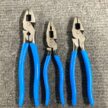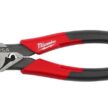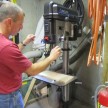Tsunoda Pliers
High Quality From Japan
The Tsunoda pliers we look at here are a great example of quality tools from Japan. There are a handful of countries with a reputation for producing top-quality goods, and Japan is certainly one of them. While hand tools from Europe have gotten most of the attention in this regard lately, hand tools from Japan are starting to get noticed and praised by users.
Japanese screwdrivers have been extolled for a while among auto and electronic technicians. Now, pliers from Japan are getting their due in many trades. Tsunoda is one of the best-known manufacturers of pliers in Japan and they were kind enough to send over a sample of their products. Those five pliers– lineman’s, two dykes, needle nose, and a cool cable tie plier — are not even close to the full product breadth of pliers made by Tsunoda, but they provide an idea of what the company provides.
Here’s the bottom line up front. Tsunoda pliers perform as well as the top-tier American and European pliers that I’ve used. But they have superior fit and finish, and their top-tier performance is available (now, at least) at mid-tier prices.
Common Features of Tsunoda Pliers
The fit and finish is top-notch on all these tools. Surfaces are either polished or have a protective coating on them. All edges that could meet a hand are crisp, but not sharp. The fit of the pivot pin to the handles is precise. Mating knife edges meet perfectly with no light showing between them. Surfaces in the same plane are perfectly aligned. Things that come to a point come to a perfect point.
All the pliers that I received had PVC dipped handles, but Tsunoda also offers most models with thicker “comfort” handles (what they refer to as “TG” handles). In contrast to many American brands, the thick dipped plastic was slightly tackier with just a hint of cushioning. All the markings on the pliers I received were in English (the packaging was mostly in Japanese, but the translate app on your phone will translate it).
The pivot pins were precisely mated to their corresponding handle holes – there was no indication throughout the handle travel that anything was out-of-round. This precise match meant that the handles did not freely fall open, which is true of most pliers and is something that many users prefer. The amount of pressure required to open each plier varied slightly, but I would describe it generally as moderate compared to other brands.
Note: While I have average size hands, I am not a big guy, I’m no longer young, and my hands have some arthritis. So make the appropriate adjustment to your own situation when I describe the effort required to perform a task.
All Tsunoda pliers are forged, heat treated, and the cutting edges induction hardened. I was surprised to see that every cutting edge is touched up by hand with a stone by an experienced technician (video here)!
While Tsunoda is a very popular brand in Japan, they are available in the States and Canada only through Amazon. I provide the links to Amazon.com and the prices in USD below. (They are also available in Canada on Amazon.ca) Like many Japanese brands, the numerals in the model number refer to the tool’s length in mm. For example, the PP-220 pliers described next are 220 mm long (7.9-inches).
Finally, I don’t know what wire gauges are most common in Japanese homes and businesses. But since Japan’s residential line voltage is 100 volts, I assume that the most common wire sizes there (measured in mm) roughly correspond to 14 and 12 AWG here. For that reason, I mainly use 12/2 with ground and 14/2 with ground romex in evaluating these pliers, since these are the bread-and-butter gauges in U.S. residential and most commercial settings.
Tsunoda PP-200 Power Pliers
Model PP-220 is a classic American lineman’s-style plier with an OAL of 7.9 inches. The specs provided by Tsunoda are:
- Length: 7.9 inches (200 mm)
- Weight: 12.5 oz
- Cuts: soft iron wire: diameter 0.1 inch (3.2 mm), soft copper wire: diameter 0.2 inch (4 mm)
- Cuts stainless steel wire: 0.1 inch (2 mm) diameter
- VVF: 2.6 x 3 cores
- Currently $24 on Amazon.com

The wire sizes above refer to cutting capability. I believe “VVF” refers to what we’d call romex in the States, and the spec above means 2.6mm diameter copper wire by 3 strands, or pretty much 10/2 w/ground romex, which is in line with my experience (below).
These are basically 8-inch lineman’s — an inch shorter than the traditional 9 inches, but a size that many electricians are moving to. In the States, 9- or 9.5-inch lineman’s became the “standard” because this size was necessary to work with the 19th century 8 AWG steel telegraph wire that lineman’s were developed for. But many in the trade are finding that for working with 14- or 12-gauge wire – the common sizes in residential and most commercial buildings – an 8-inch lineman’s is more comfortable, more nimble, less fatiguing, and just as effective.
The PP-220 is a great version of an 8-inch lineman’s. The fit and finish, as described above, is outstanding (these were the only pair of those sent that had only one side polished). There is absolutely no wobble or handle-to-handle play, even with one handle locked in a vise. The handles are comfortable and fit my average-size hands well. The pliers are very nimble in the hand. The balance is such that you always have a good feel for where the head is, but not so head-heavy as to feel like you’re fighting gravity all the time.

They cut 14/2 w/ground and 12/2 w/ground romex with the same effort as other top-tier 8-inch linemans’ that I have. As the specs indicate, I could cut 10/2 w/ground with them, but that would be the practical limit. There is a distinct “snap” as the cut finishes.
They differ from American and European lineman’s pliers in the jaw teeth. They are not cross-hatched, but rather linear grooves across the width of the jaws. This choice of tooth geometry performs as you’d expect. In grabbing and holding onto things, it made no difference; I was able to grab steel fish tape and pull with all my strength and body weight without the teeth slipping. Likewise, I could grab the edge of romex insulation and tear it away easily. In twisting 12 gauge wire I did notice some decrease in effectiveness over cross-hatched teeth, but it was slight – I’d subjectively put it at maybe 7-8 percent.
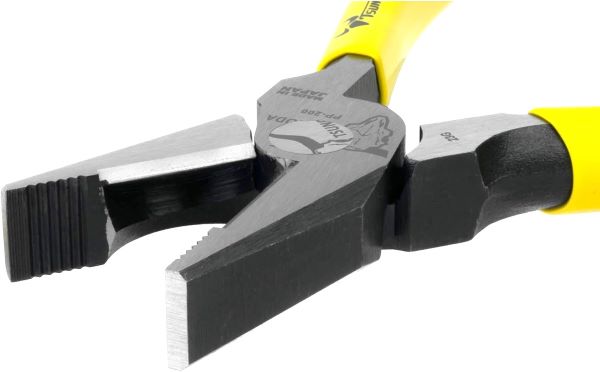
I was glad to see that the jaws on the PP-220 Tsunoda pliers are a full ½-inch wide. This width allows them to grasp and twist 4 strands of 12 gauge wire without having to be super fussy about getting the strands arranged “just right”.
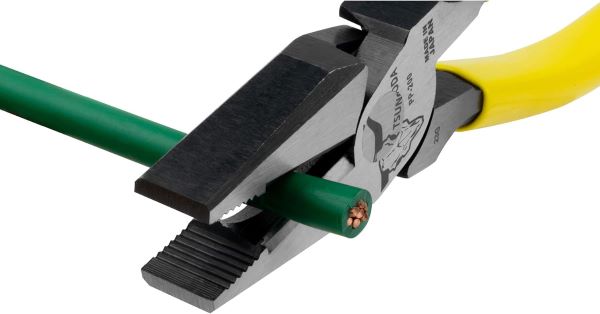
Tsunoda PUN-200 and PKN-200 Diagonal Cutter Pliers
Tsunoda sent along two pair of diagonal cutters (“dykes”), which they refer to as “nippers”. The PUN-200 is referred to as a “thin blade nipper” while the PKN-200 is referred to as a “hard wire nipper”. The company explained the difference to me in the following.
The PUN-200 has sharp single-beveled cutting edges, which are rated for cutting soft material only (plastic, copper or soft iron). This model was developed for electricians in order to cut mainly copper core cable. The sharp cutting edges provide effortless cutting and a clean cutting surface. However, sharpness and durability for cutting edge is always trade-off. Please note that it (the PUN-200) can be damaged easily if you cut an object above its cutting rate. On the other hand, the PKN-200 is a versatile model capable of cutting hard metal. I love that Tsunoda makes a model that is specifically engineered to perform better on select materials, and they trust tradesmen to respect the tool’s performance envelope. American manufacturers, by contrast, would generally assume (rightly) that American tradesmen would tend to ignore a tool’s limitations, use it for tasks for which it wasn’t intended, and then blame the tool when it failed or broke! PUN-200 Specs:
- Size: 7.9 inches (200 mm)
- Weight: 9.5 oz (268 g)
- Cuts soft iron wire: diameter 0.1 inch (2.6 mm), soft copper wire: diameter 0.2 inch (4 mm)
- VVF: 2.6 x 3 cores
- 268 grams
- Currently $24 on Amazon.com

PKN-200 Specs:
- Size: 7.9 inches (200 mm)
- Weight: 9.8 oz (276 g)
- Soft iron wire: diameter 0.1 inch (3.2 mm), soft copper wire: diameter 0.2 inch (5 mm)
- Stainless steel wire: 0.06 inch (1.6 mm) diameter
- VVF: 2.6 x 3 cores
- Currently $24 on Amazon.com
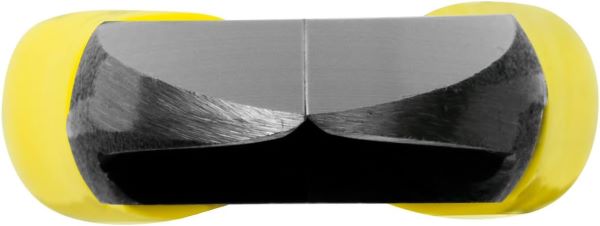
All the above comments regarding the fit and finish on these two models apply. Comparing their fit and finish to some high-end American dykes…well, there’s no comparison in this regard – the Tsunoda models are superior. Like the PP-200 lineman’s, the handles don’t fall apsrt, but require a normal amount of finger pressure to open.
The PKN-200 pliers – the ones meant for more general-purpose cutting – cut both 12/2 w/ ground and 14/2 w/ground with the same amount of force required using similar pairs of 8-inch high-end American dykes. The PUN-200, by contrast, cut both cables with significantly less force. In fact, you can feel the difference in blade sharpness with your finger.
In the hand, both pliers are comfortable and lively. Like the PP-200 lineman’s, they are just a tad smaller in my average-size hand than a typical corresponding American plier, but very comfortable. The jaws are a bit narrower and more pointed than a typical American dyke, a feature that I appreciate. That’s because many electricians use dykes mainly for snipping wire in hard-to-reach locations, such as inside a box or panel. For easy-to-reach wires they will usually just use their lineman’s.
Tsunoda PR-150 Needle Nose Pliers
Tsunoda makes many models of needle nose (long nose) pliers, called “radio” pliers. As an example, they sent along a pair of model PR-150. This is a 6-inch plier with jaw teeth and a cutter. It’s smaller than I’d use for line voltage wire gauges, but very suitable for low voltage conductors, as well as countless other tasks in the other trades. Tsunoda PR-150 Specs:
- Size: 5.9 inches (150 mm)
- Weight: 4.2 oz (129 g)
- Soft iron wire: diameter 0.08 inch (2 mm), soft copper wire: diameter 0.12 inch (3.2 mm)
- Stainless steel wire: 0.05 inch (1.2 mm) diameter
- Stranded: 0.14 in (3.5 mm)
- Currently $20 on Amazon.com

As with the other pliers here, the fit and finish of the PR-150 is superb. The dipped handles, combined with the overall weight and balance and the fine tip, make for a very precise and dexterous tool. You can feel the precise fitting as you use the tool. Tsunoda needle nose pliers seem to have gotten the lion’s share of the limited press that Tsunoda has got in the States – it was people singing their praises that got me interested in Tsunoda to begin with.
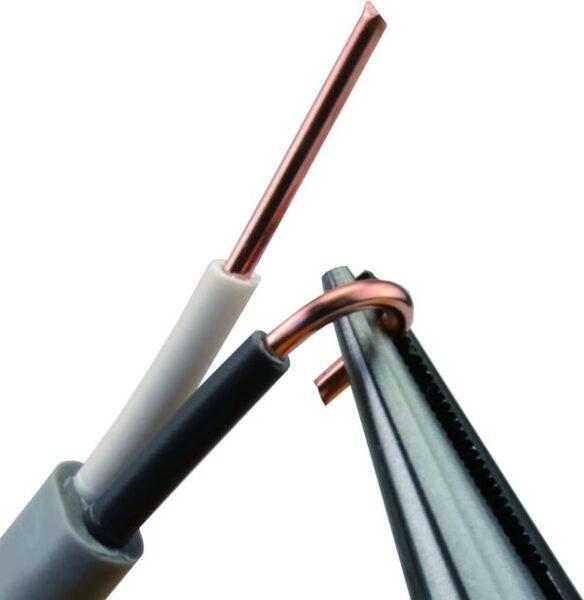
The cutting blades on these small pliers were impressive. To my surprise, I could cut through 14/2 w/ground romex with great ease. I couldn’t get them to cut 12/2 w/ground though, although individual strands of either gauge were snipped like the proverbial butter. From such small pliers with such a short lever arm I did not expect this level of cutting ability. The tips could even pick up a hair.
Given the level of these pliers, as well as of the pairs I discussed above, I see no reason why one of Tsunoda’s needle nose pliers, in the size that suits your hand and application, won’t deserve the praise they have received, in whatever tasks you use needle-nose pliers for.
Tsunoda KBN-150 Cable Tie Cutter
This 6-inch flush-cut cable tie cutter is unique (or at least so unusual that I haven’t seen one like it elsewhere). All the praise directed at the other pliers above regarding fit, finish, tight tolerances, perfect alignment, etc., applies to the KBN-150 too. But it’s the dual function of the tool that’s really interesting, and really useful. You can see from the pictures that it incorporates precision flush-cutting blades, and to the back of both blades is a serrated section that you use to hold onto the free end of the cable tie and cam it tight.
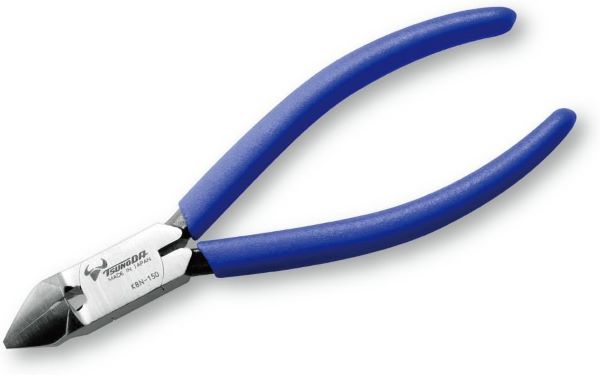
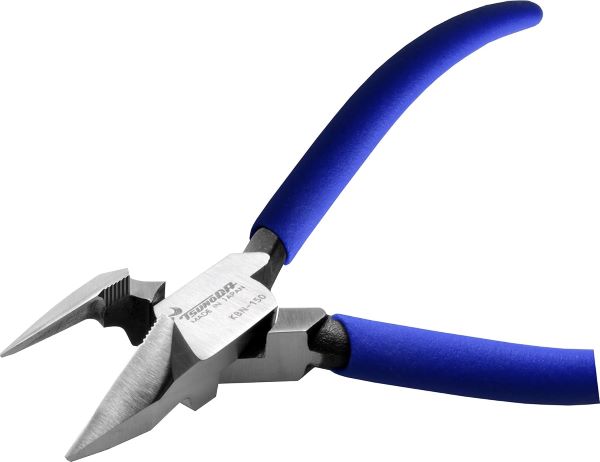 This design is extremely workflow efficient. If you use regular flush cutters, you have to use one pair of pliers to cam the tie tight, put that tool down, pick up a set of cutters, and then cut the tie…and repeat. With the KBN-150 you never have to change tools, and it fits in the hand so well that you can still acquire and manipulate cable ties with it in your hand; the tool never has to leave your hand as you set and tighten as many cable ties as you need.
This design is extremely workflow efficient. If you use regular flush cutters, you have to use one pair of pliers to cam the tie tight, put that tool down, pick up a set of cutters, and then cut the tie…and repeat. With the KBN-150 you never have to change tools, and it fits in the hand so well that you can still acquire and manipulate cable ties with it in your hand; the tool never has to leave your hand as you set and tighten as many cable ties as you need.
Yes, there are pistol-grip cable tie tools that can do both functions, but they are bulky. They don’t fit in a tool pouch well, and they take up a lot more room in your hand so you may have to set it down in order to set the tie. For most technicians and trades people, most of the time, the KBN-150 is a more efficient choice.


And it works extremely well. The tightening section works as well as any plier I’ve used for that task, and the cutters cut the tie perfectly flush. If you are careful to fully seat the blades against the female section of the cable tie, there is no sharp nub of the running end sticking out once it’s cut.
KBN-150 Specs:
- Cutting capacity: cable tie up to 0.31-Inch width
- Cutting capacity (AWG) : Soft iron 14 / Copper 10 / Strand copper wire 10 / Brass 12 / Plastic 4mm
- Currently $21 on Amazon.com
Suggestions
You can see that I’m impressed with Tsunoda pliers. But I have two suggestions for Tsunoda.
I would consider making some plier models with fall-free handles, even at the expense of the tiniest bit of play at the pivot pin. That play will almost never increase with use, yet the convenience of easier-opening handles will be a bonus for many potential customers. However, the handles aren’t difficult to open as they are, and many trades people actually prefer non fall-free handles.
I would also suggest cross-hatched jaw teeth on electrical pliers. The current linear teeth twist wires well, but cross-hatched teeth would do better with no downside that I can see.
Bottom Line
Keeping in mind what a reviewer can and cannot do, and as I said up top, Tsunoda pliers perform as well as the top-tier American and European pliers that I’ve used. But they have superior fit and finish, and their top-tier performance is available (now, at least) at mid-tier prices.
You do have to order them from Amazon; they aren’t available in stores or at your local trade supplies distributor. However, they are so inexpensive that you will want to give them a try. You may wind up with a new favorite tool.
The company tells me that they are in the process of unifying their branding and simplifying their product offerings, so some products may be eliminated, re-branded, or superseded in the future. If you have any questions, I found that Tsunoda is very responsive to questions asked through the contact form on their website.




